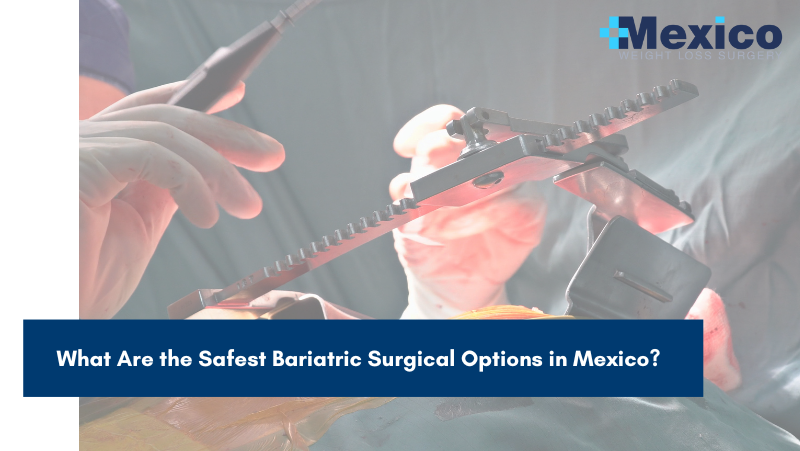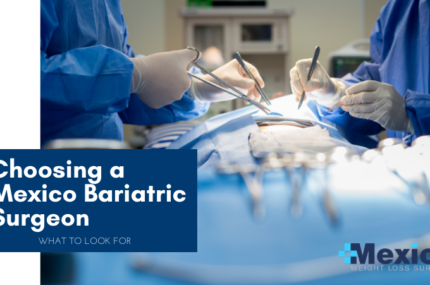What Are the Safest Bariatric Surgical Options in Mexico?

Bariatric surgery is one of the most effective ways to lose weight and address serious obesity-related health issues, including hypertension, diabetes and sleep apnea. If you are considering bariatric surgery, you likely have questions about each option and potential complication rates. Like any other procedure, bariatric surgery has a slight complication risk. However, Mexico’s bariatric clinics are known for their outstanding care and hospitality, and studies show that the complication rates mirror those in the United States. By understanding each procedure and associated risks, you can make the right decision for your needs.
Gastric Sleeve Surgery
Gastric sleeve surgery (vertical sleeve gastrectomy) is one of the most prevalent bariatric procedures due to its high expected weight loss rates and minimal complications. For many, it is the procedure of choice for efficient weight loss. During a gastric sleeve procedure, the surgeon removes about 80%-85% of the stomach, leaving less room for food intake. This procedure causes patients to feel fuller more quickly after eating considerably less.
Gastric sleeve surgery is minimally invasive. However, it does require general anesthesia. Gastric sleeve surgery in Mexico is low-risk, and complication rates are similar to rates in the United States at about 2.2%. The most common complications include:
- excess bleeding
- blood clots
- infection
- malnutrition
These side effects are usually minor and easily manageable when addressed promptly. In addition, many side effects are avoidable if the patient adheres to dietary and activity guidelines as instructed by their doctor.
Gastric Bypass Surgery
While gastric sleeve surgery is the most popular bariatric procedure today, gastric bypass surgery is an excellent option for many patients. Instead of creating a smaller stomach by cutting and forming a sleeve shape, the surgeon creates a pouch at the top of the stomach with a plastic band or surgical staples. The pouch then attaches to the small intestine. This process allows food to bypass the other portions of the stomach and the upper part of the small intestine. As a result, less caloric absorption occurs, and the patient feels fuller with smaller meals.
The complication rates associated with gastric bypass are still relatively small at 3.6%. Dumping syndrome is one of the most common complications. This condition causes food to pass too quickly through the stomach and intestinal tract. Symptoms include nausea, diarrhea and weakness. Additional complications associated with gastric bypass surgery are:
- infection
- nutritional deficiency
- hernia
- flu-like symptoms
Weight loss after gastric bypass surgery is slower than that experienced after gastric sleeve surgery, although sustained weight loss rates are comparable.
Duodenal Switch
Duodenal switch procedures are associated with the highest rates of weight loss among all bariatric procedures. A duodenal switch requires a combination of malabsorptive and restrictive procedures to achieve the maximum weight loss potential. One of the main benefits is that the pylorus (stomach opening) remains intact, allowing it to empty the food content into the duodenum.
A vertical sleeve gastrectomy is the first component of a duodenal switch, which requires the surgeon to create a smaller stomach. This procedure fulfills the restrictive element of the process. After the vertical sleeve gastrectomy, the surgeon connects the upper and lower small intestine, bypassing the middle. This part of the procedure disrupts nutrient absorption.
In addition to these procedures, some surgeons also decide to conduct a preventative gallbladder removal surgery. A common complication of rapid weight loss is the formation of gallstones. Prophylactic gallbladder removal may prevent the need for further surgical intervention by eliminating the possibility of gallstone formation.
Duodenal switch procedures are associated with a slightly higher rate of complications. Significant complication rates occur in 3% of patients, while minor complications occur in about 2.5%. Most commonly, the complications include:
- duodenal or gastric leak
- abscesses
- blood clots
- obstruction
Many of these complications are preventable. While unavoidable complications occasionally arise, they are highly treatable when diagnosed early. One study found the overall operative mortality rate to be 1% which is comparable to the mortality rate seen in gastric bypass procedures.
Gastric Balloon Surgery
Gastric balloon surgery is one of the newest bariatric surgical procedures available. A gastric balloon surgery involves the placement of an inflatable balloon to restrict stomach size. A primary benefit of this procedure is that many different options are available. Other benefits of gastric balloon surgery are that it is:
- less invasive
- temporary
- reversible
- cheaper
- available on an outpatient basis
During most of these procedures, the balloon is placed into the stomach through an upper gastrointestinal tract endoscopy under general sedation. After placement, the balloon is then filled with saline or air and floats within the stomach cavity. Some gastric balloon procedures do not require endoscopy for placement.
The mechanism of this procedure is similar to restrictive bariatric operations since the balloon limits the amount of space for food in the stomach. A gastric balloon creates a sensation of fullness after eating far fewer calories than usual. After inflation, a gastric balloon takes up approximately 80% of space within the stomach. The patient will notice a reduced food intake and considerable weight loss through appropriate dietary and lifestyle modifications.
Gastric balloon procedures are generally well tolerated and very successful. However, they still carry a low risk of complications, including:
- gastric ulcers
- spontaneous deflation
- overinflation
- pancreatitis
- perforation
Complication rates are dependent upon the specific type of gastric balloon surgery option chosen. For example, the most common complications associated with intragastric balloon placement are pain (33.7%) and nausea (29%).
Like bariatric procedures in the United States, weight loss surgery in Mexico is safe and effective, with comparable risks of complications. If you’re interested in learning more about each bariatric surgery option and finding out if you’re eligible, schedule a free consultation with Renew Bariatrics today.
FEATURED BLOGS
How to Choose Mexico Bariatric Surgeon
Concerns about having a bariatric procedure is a normal and expected element of the decision. These worries are…
Read MoreWhich Bariatric Surgery is Best?
Obesity is one of the most common health issues in America. Obesity may further lead to a number of…
Read More
